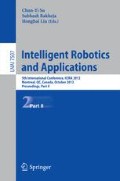Abstract
In this paper, we establish a time-varying fuzzy Markov model to estimate human intention for natural non-verbal human robot interface. Based on human posture information, we change the probability between states to improve the accuracy of estimation of human intention. The advantages of the approach are three fold: i) non-verbal information is core of natural interaction; ii) time-varying probability improves estimation accuracy; and iii) fuzzy inference consider practical human experience.
Access this chapter
Tax calculation will be finalised at checkout
Purchases are for personal use only
Preview
Unable to display preview. Download preview PDF.
References
Matsumoto, Y., Sasao, N., Suenaga, T., Ogasawara, T.: 3D model-based 6-dof head tracking by a single camera for human-robot interaction. In: IEEE International Conference on Robotics and Automation, ICRA 2009, pp. 3194–3199 (May 2009)
Yu, E., Aggarwal, J.: Human action recognition with extremities as semantic posture representation. In: IEEE Computer Society Conference on Computer Vision and Pattern Recognition Workshops, CVPR Workshops 2009, pp. 1–8 (June 2009)
Juang, C.F., Chang, C.M., Wu, J.R., Lee, D.: Computer vision-based human body segmentation and posture estimation. IEEE Transactions on Systems, Man and Cybernetics, Part A: Systems and Humans 39(1), 119–133 (2009)
Ho, Y., Shibano, T., Sato-Shimokawara, E., Yamaguchi, T.: The information providing system by using human motion recognition. In: 2011 4th International Conference on Human System Interactions (HSI), pp. 110–116 (May 2011)
Ye, Y.: Design and implementation of a real-time image processing based e-home robot (2003)
Chen, Y.H., Lu, C.H., Hsu, K.C., Fu, L.C., Yeh, Y.J., Kuo, L.C.: Preference model assisted activity recognition learning in a smart home environment. In: IEEE/RSJ International Conference on Intelligent Robots and Systems, IROS 2009, pp. 4657–4662 (October 2009)
Dey, A.: Understanding and using context. Personal and Ubiquitous Computing 5(1), 4–7 (2001)
Oyama, K., Jaygarl, H., Xia, J., Chang, C., Takeuchi, A., Fujimoto, H.: A human-machine dimensional inference ontology that weaves human intentions and requirements of context awareness systems. In: 32nd Annual IEEE International Computer Software and Applications, COMPSAC 2008, July 28-August 1, pp. 287–294 (2008)
Chang, C., Yi Jiang, H., Ming, H., Oyama, K.: Situ: A situation-theoretic approach to context-aware service evolution. IEEE Transactions on Services Computing 2(3), 261–275 (2009)
Koo, S., Kwon, D.S.: Recognizing human intentional actions from the relative movements between human and robot. In: The 18th IEEE International Symposium on Robot and Human Interactive Communication, RO-MAN 2009, September 27-October 2, pp. 939–944 (2009)
Kuan, J.Y., Huang, T.H., Huang, H.P.: Human intention estimation method for a new compliant rehabilitation and assistive robot. In: Proceedings of the SICE Annual Conference 2010, pp. 2348–2353 (August 2010)
Han, J.H., Kim, J.H.: Human-robot interaction by reading human intention based on mirror-neuron system. In: 2010 IEEE International Conference on Robotics and Biomimetics (ROBIO), pp. 561–566 (December 2010)
Zhang, X., Wang, B., Wang, X., Sugi, T., Nakamura, M.: Human intention extracted from electromyography signals for tracking motion of meal assistance robot. In: IEEE/ICME International Conference on Complex Medical Engineering, CME 2007, pp. 1384–1387 (May 2007)
Morency, L.P.: Modeling human communication dynamics [social sciences]. IEEE Signal Processing Magazine 27(5), 112–116 (2010)
Kwak, K.C., Kim, S.S.: Sound source localization with the aid of excitation source information in home robot environments. IEEE Transactions on Consumer Electronics 54(2), 852–856 (2008)
Krauss, R., Fussell, S.: Social psychological models of interpersonal communication. In: Social Psychology: Handbook of Basic Principles, pp. 655–701 (1996)
Mehrabian, A.: Nonverbal communication. Aldine (2007)
Navarro, J., Marcin Karlins, P.: What every body is saying: An Ex-FBI Agent’s Guide to Speed-Reading People (2009)
Awad, M.A., Khalil, I.: Prediction of user’s web-browsing behavior: Application of markov model. IEEE Transactions on Systems, Man, and Cybernetics, Part B: Cybernetics PP(99), 1–12 (2012)
Ge, H., Asgarpoor, S.: Reliability evaluation of equipment and substations with fuzzy markov processes. IEEE Transactions on Power Systems 25(3), 1319–1328 (2010)
Tamura, Y., Sugi, M., Ota, J., Arai, T.: Deskwork support system based on the estimation of human intentions. In: 13th IEEE International Workshop on Robot and Human Interactive Communication, ROMAN 2004, pp. 413–418 (September 2004)
Baldwin, D., Baird, J.: Discerning intentions in dynamic human action. Trends in Cognitive Sciences 5(4), 171–178 (2001)
Kowalczuk, Z., Czubenko, M.: Model of human psychology for controlling autonomous robots. In: 2010 15th International Conference on Methods and Models in Automation and Robotics (MMAR), pp. 31–36 (August 2010)
MacRae, E.: Estimation of time-varying markov processes with aggregate data. Econometrica: Journal of the Econometric Society, 183–198 (1977)
Author information
Authors and Affiliations
Editor information
Editors and Affiliations
Rights and permissions
Copyright information
© 2012 Springer-Verlag Berlin Heidelberg
About this paper
Cite this paper
Liu, P., Yang, CE. (2012). Human Intention Estimation Using Time-Varying Fuzzy Markov Models for Natural Non-verbal Human Robot Interface. In: Su, CY., Rakheja, S., Liu, H. (eds) Intelligent Robotics and Applications. ICIRA 2012. Lecture Notes in Computer Science(), vol 7507. Springer, Berlin, Heidelberg. https://doi.org/10.1007/978-3-642-33515-0_20
Download citation
DOI: https://doi.org/10.1007/978-3-642-33515-0_20
Publisher Name: Springer, Berlin, Heidelberg
Print ISBN: 978-3-642-33514-3
Online ISBN: 978-3-642-33515-0
eBook Packages: Computer ScienceComputer Science (R0)

